Featured Comment:
“I just made this, thank you! Marinate the fish in sake gives them extra oomph factor, nice!”
– Mentari
What is Saba no Shioyaki (Japanese-style Grilled Mackerel)?
Saba no shioyaki (鯖の塩焼き) is a traditional dish crafted with mackerel fillets seasoned lightly with salt and then grilled to perfection. In Japanese, “Saba” translates to “mackerel,” while “shioyaki” denotes “salt grill.”
This dish is special in Japanese households, often gracing dinner tables accompanied by freshly cooked rice, miso soup, and pickles. However, it’s versatile enough to be a choice for lunch, dinner, or even breakfast.

Japan boasts a variety of mackerel, including:
- Blue mackerel
- Indian mackerel
- Double-lined mackerel
- Chub mackerel
Strolling through Japanese supermarkets, one might notice a significant portion of mackerel imported from Norway, in fact, 90% of imported mackerel in Japan is from Norway.
Mackerel’s presence in Japanese culture is longstanding. Archaeological findings from the Jomon era (circa BC 3000 to BC 100) have revealed mackerel bones, suggesting its consumption dates back to ancient times.
Historically, mackerel wasn’t just a staple for the common folk; it also graced the plates of the aristocracy.
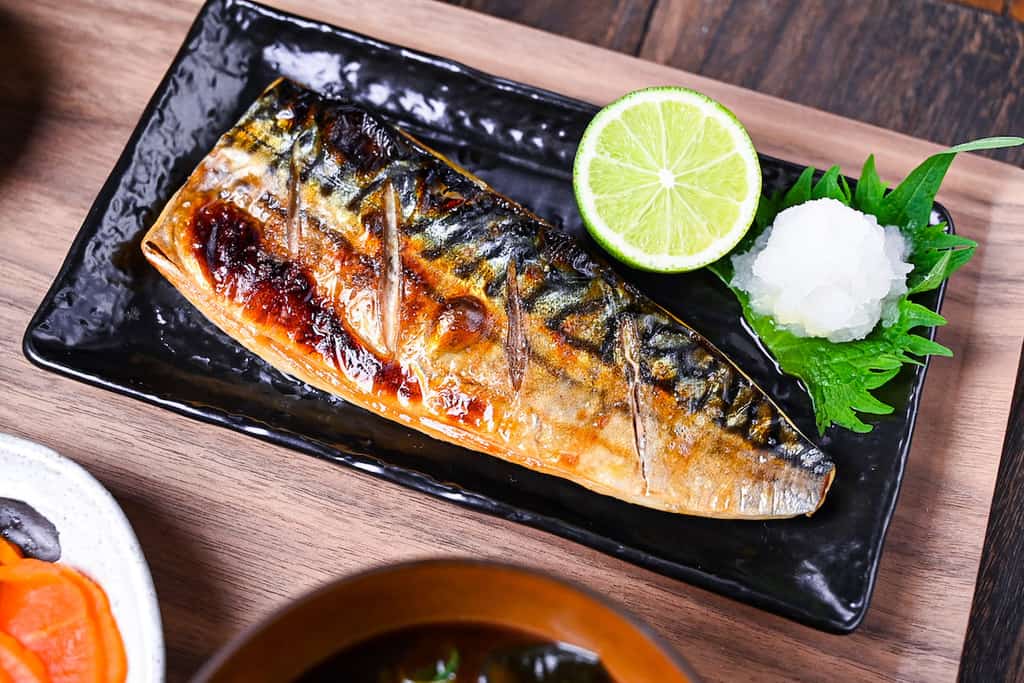
How We Eat Mackerel in Japan
As one of the most popular types of fish in Japan, we eat mackerel in many different ways, such as:
- Salted and grilled (saba no shioyaki)
- Saba miso (simmered in miso base sauce)
- Karaage (deep fried)
- Sushi
- Shime saba (pickled)
- Saba katsu (breaded deep-fried mackerel)
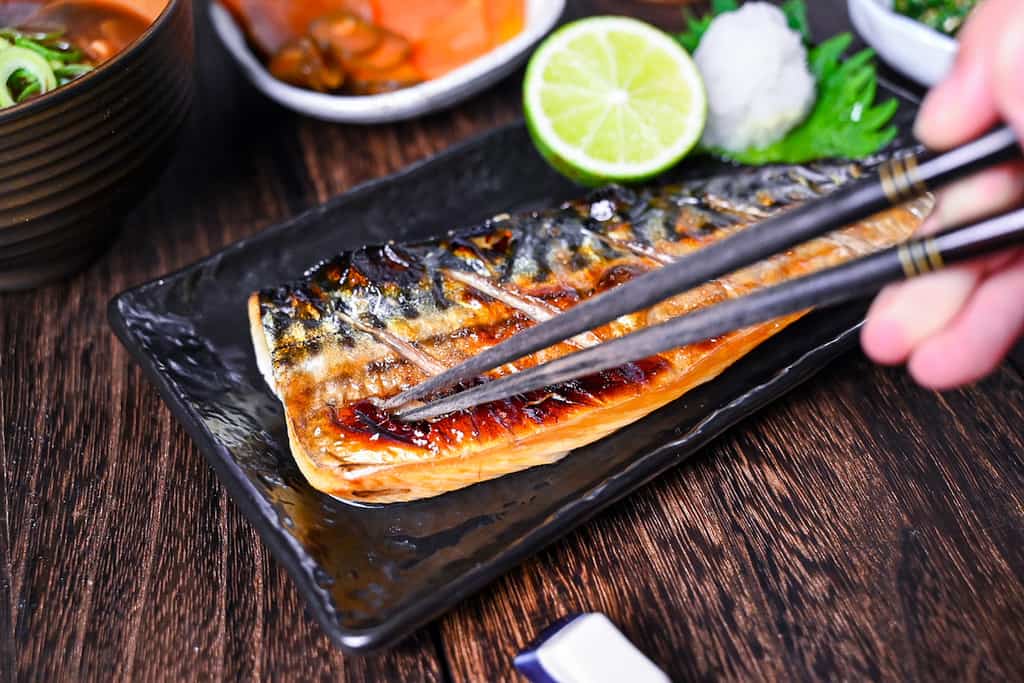
Ingredients & Substitution Ideas
- Mackerel fillets (skin-on): Choose mackerel with firm flesh, tight skin, and distinct white lines (a sign of good fat content). For the best flavor, go for wild-caught, seasonal varieties. In Japan, chub mackerel (ma-saba) is at its best from fall to winter, while blue mackerel (goma-saba) is at its prime from summer to early fall.
- Sake: A little Japanese rice wine helps get rid of any fishy smells and makes the flesh nice and tender. It’s optional, but it really makes the dish.
- Salt: A pinch of high-quality sea salt is key for seasoning and bringing out the natural umami flavors of the mackerel.
- Sudachi (optional): This small, green Japanese citrus fruit perfectly complements the fish’s richness and enhances its flavor profile. If you can’t find it where you are, you can use other citrus fruits that go well with grilled mackerel. These include lemon, lime, kabosu, yuzu, or bitter orange.
- Grated daikon (optional): This finely grated Japanese radish is called oroshi daikon or daikon oroshi. It’s a great addition to fish dishes. If you can’t find daikon, try using finely grated regular radish or a small amount of prepared horseradish.
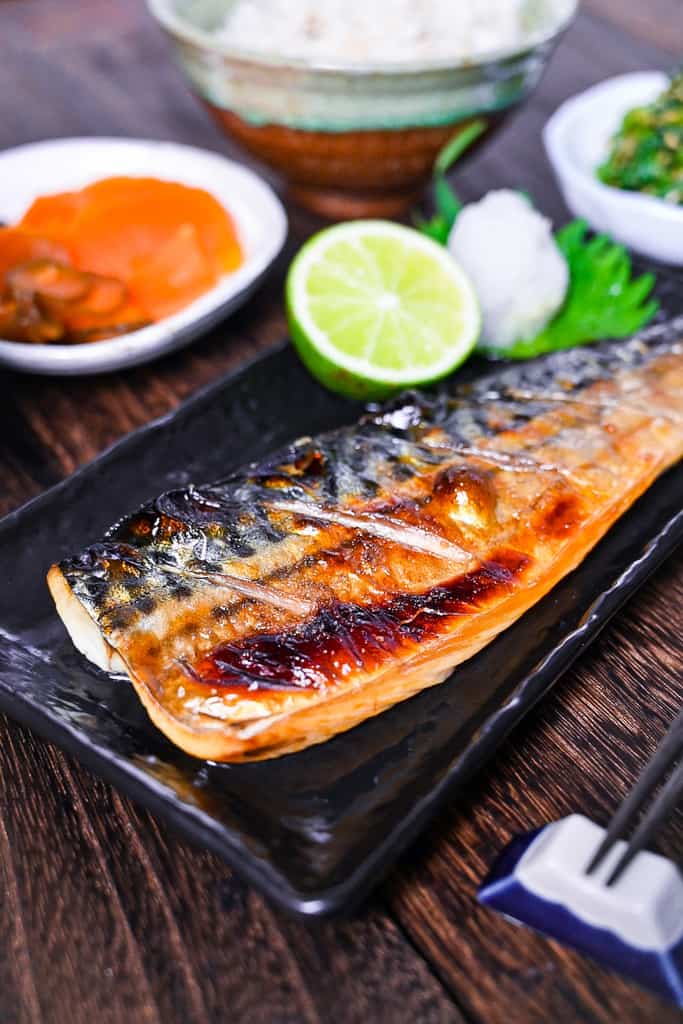
Visual Walkthrough & Tips
Here are my step-by-step instructions for how to make perfect Saba no Shioyaki every time. For ingredient quantities and simplified instructions, scroll down for the Printable Recipe Card below.
If you prefer to watch the process in action, check out my YouTube video of this recipe for a complete visual walkthrough!
Take your mackerel fillets and wash them with cold running water. Next, place them in a sealable container and rub a small amount of sake over the top.
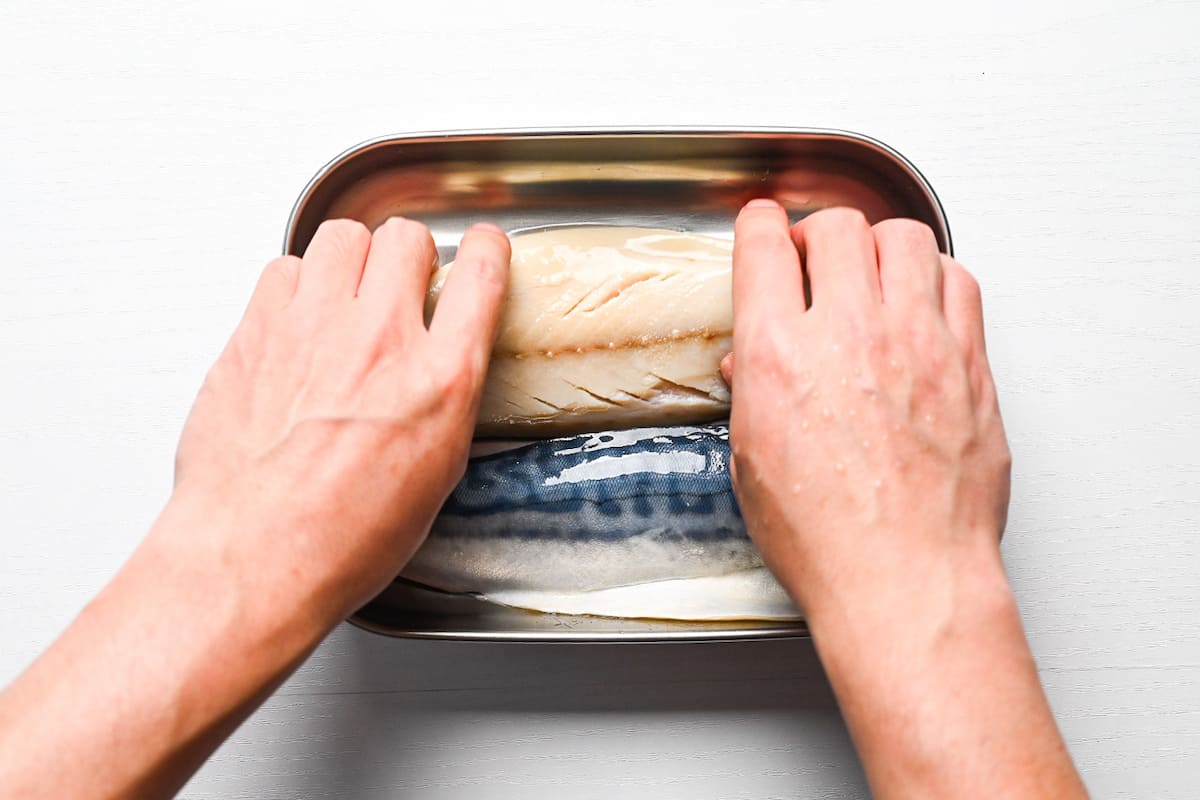
Seal with a lid and rest in the fridge for 15 minutes, 30 minutes if you have time.
Nearly every Japanese home has a fish grill for dishes like saba no shioyaki or salted salmon. It’s like a grill oven or broiler and can be used in a similar way.
Before grilling fish, it is important to ensure the oven grill is well-preheated. 3-5 minutes on a medium-high to high heat setting is usually about enough time, although this can depend on your grill, and electric grills generally take longer. Be sure to thoroughly preheat before placing your fish under the heat source.
Placing fish on a cold grill takes longer to cook and causes the skin and flesh to stick to the grill. This can negatively affect the fish’s texture, ruin its appearance, and be annoying when it’s time to wash up.
Additionally, you can lightly oil the surface of the wire rack inside the grill oven to prevent the skin and meat from sticking.
While the grill is preheating, pat the mackerel dry with kitchen paper on both sides.
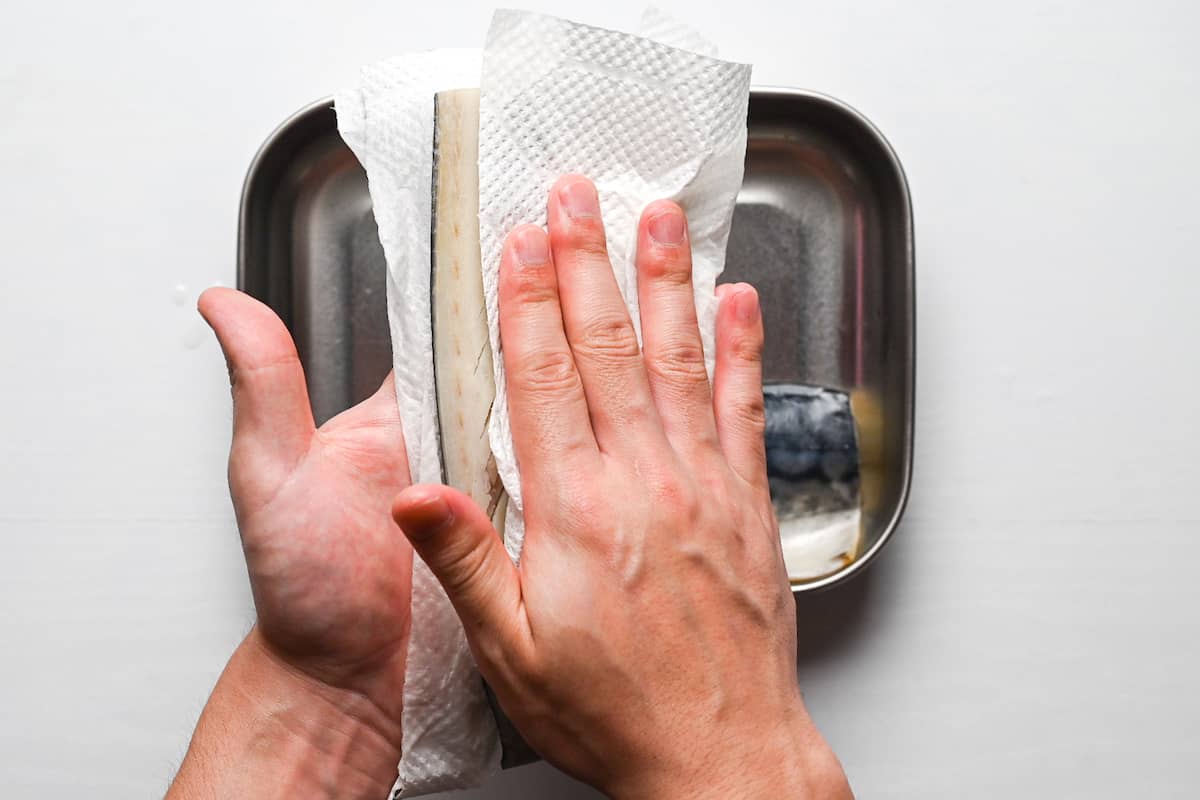
Sprinkle both sides with a generous pinch of salt. Sprinkling the salt from a height will help evenly distribute it over the surface and stop the salt from clumping together in one place.
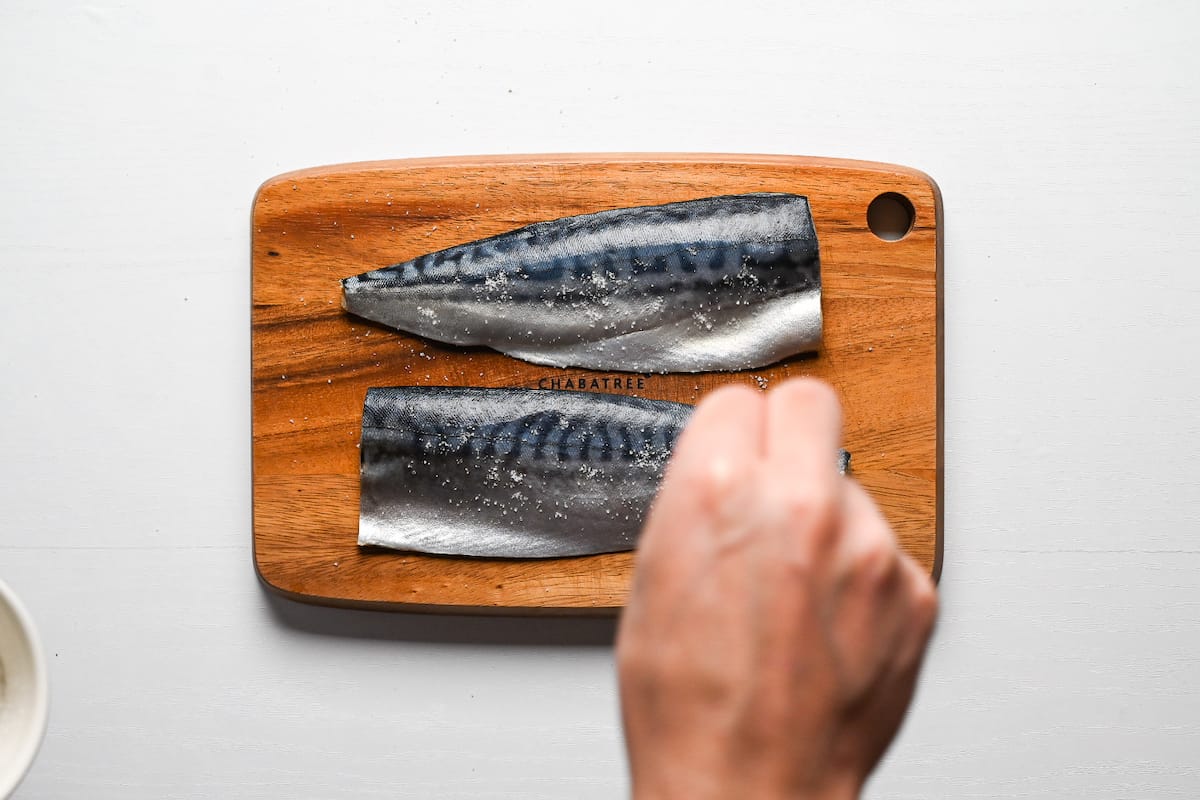
Make 3 to 4 shallow, diagonal cuts on the skin side of the mackerel, being careful not to cut too deep.
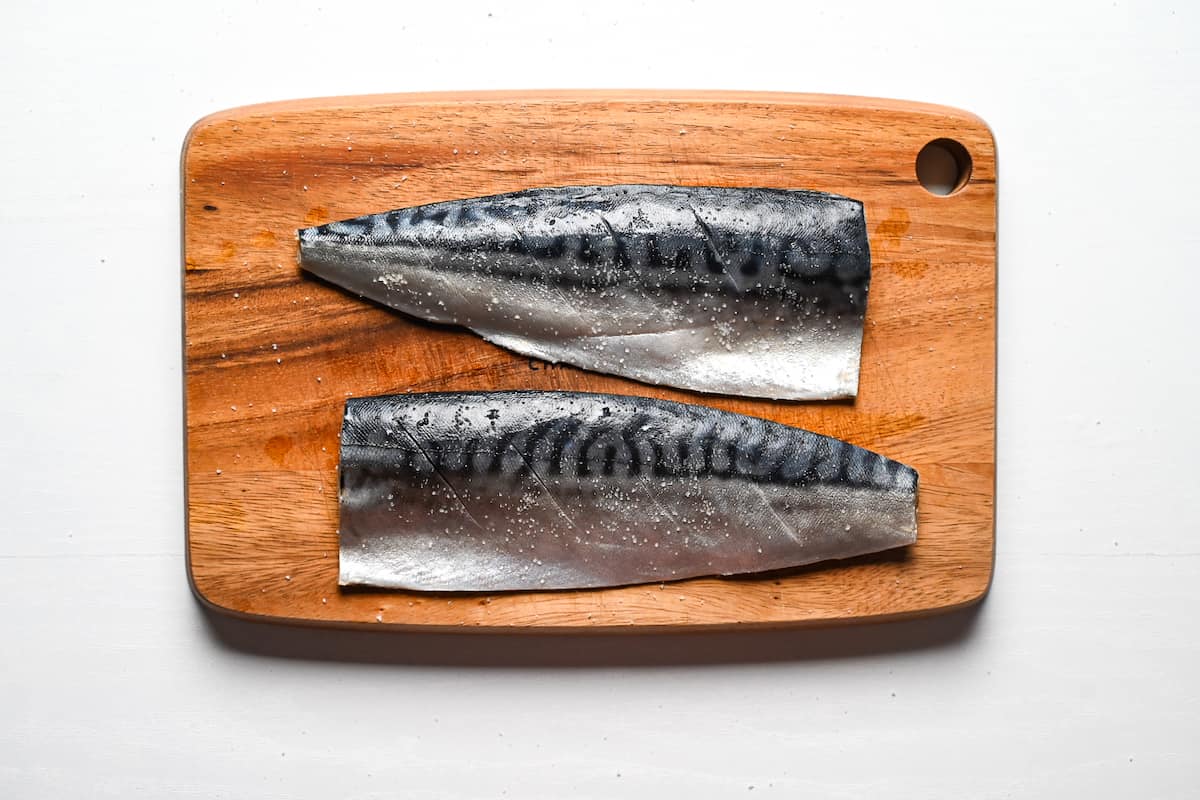
Place the mackerel fillets on the grill with the skin side down and flesh side facing the heat source. Grill/broil the flesh side for 4 minutes. You might need to increase the time by a few minutes depending on the strength of your oven grill and the thickness of your fillets.
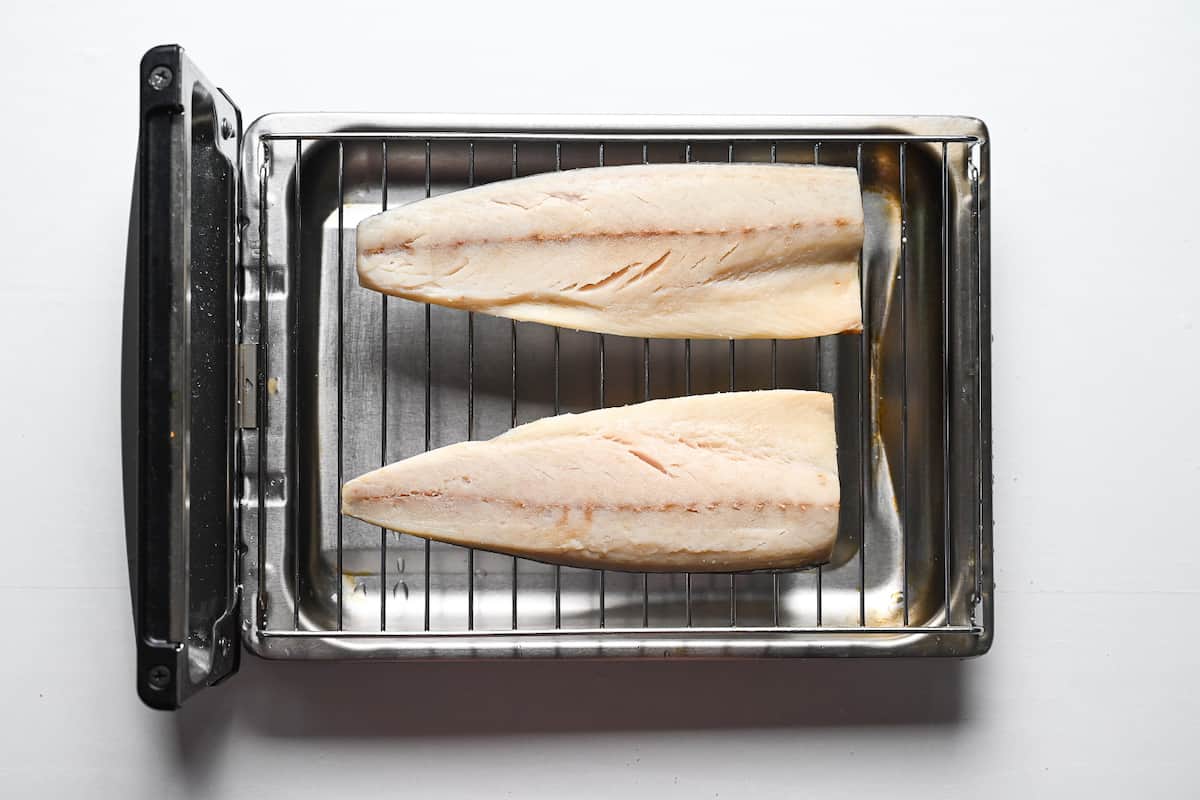
Flip the mackerel fillets over and grill the skin side for 3 minutes or until lightly charred and crispy.
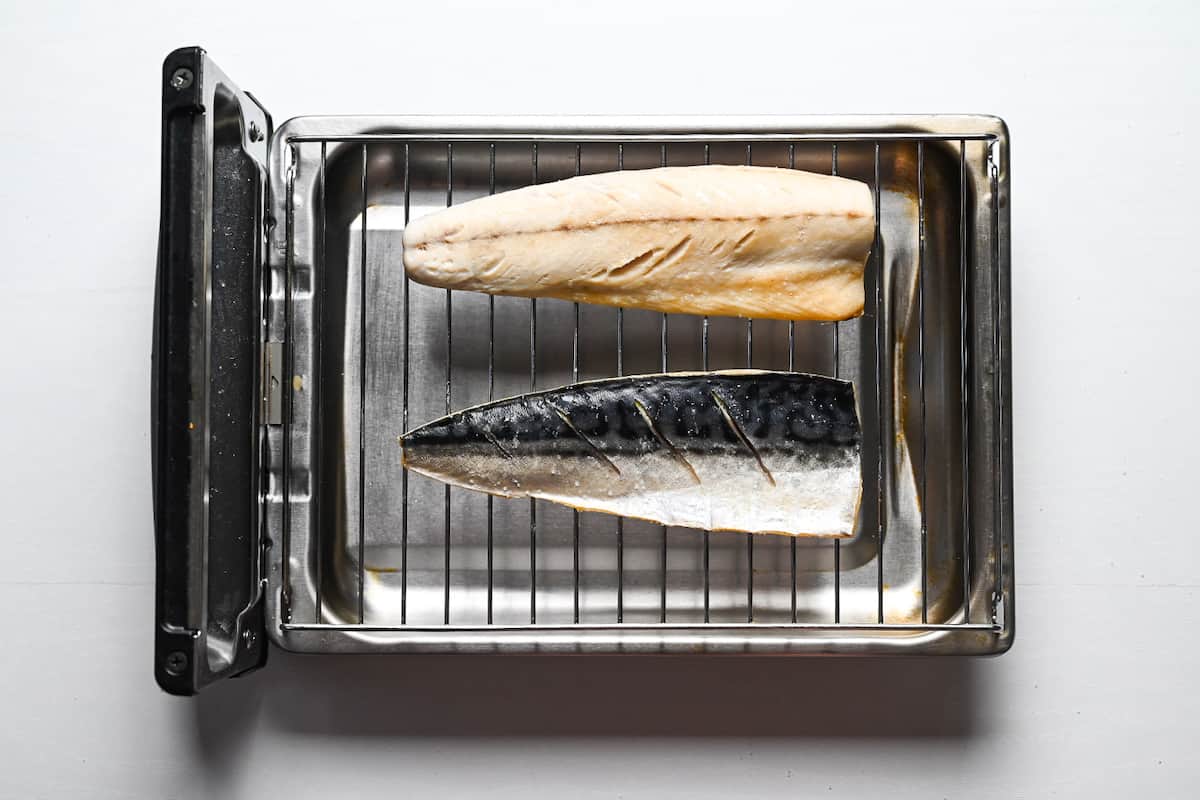
Once done, place on serving plates and serve as you like! I recommend serving with a slice of sudachi (or citrus of your choice) for squeezing and grated daikon drizzled with a touch of soy sauce for a refreshing kick!
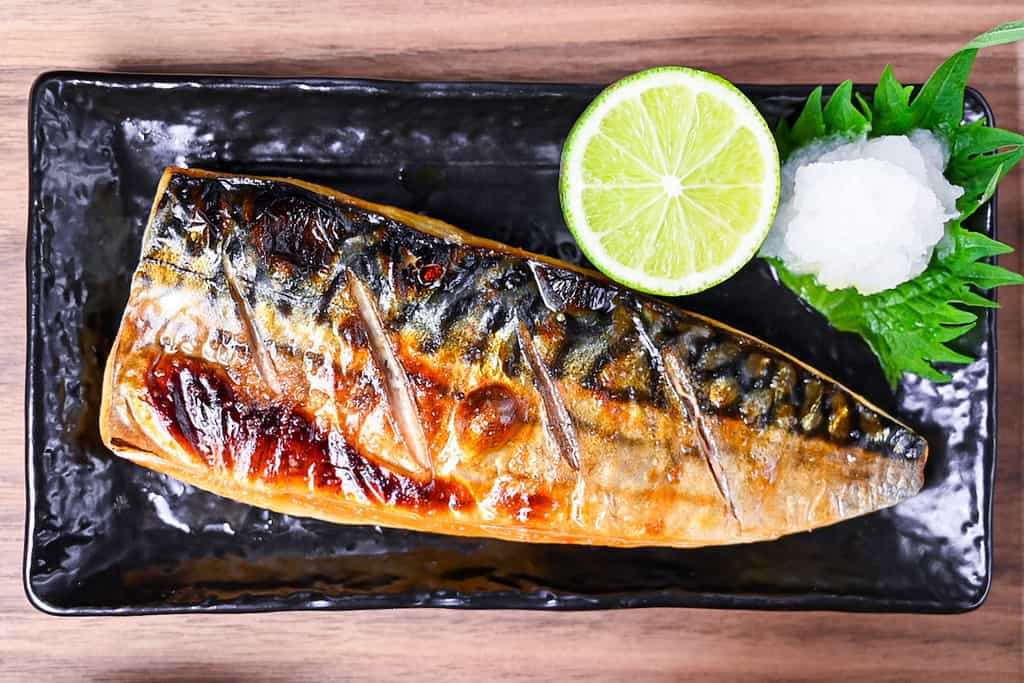
Tips & Tricks
Japanese-style grilled mackerel is a simple dish that is easy to make. However, with just a few small tricks you can ensure your home-grilled saba no shioyaki is the best it can be!
- Choose the best mackerel: For the best result, choose mackerels with firm flesh, tight skin, and visible white fat lines.
- Use sake or salt to remove unwanted odor: To mitigate the fishy aroma of mackerel when cooking, you can either sprinkle salt to draw out excess water or rub with 1 tbsp of sake. After treating, let the fillets sit for at least 15 minutes (preferably 30), then pat dry with a paper towel.
- Be generous with heat: Using low heat for grilling fish can cause it to lose essential oils and flavor, yielding a dry mackerel. It’s best to grill on medium-high to high heat: 4 minutes on the flesh side and 3 minutes on the skin side. While I use a gas oven grill, remember that cooking times might differ based on your specific grill.
FAQ
Here are answers to frequently asked questions I have received across all platforms, including here, YouTube, and Pinterest. If you have any questions, feel free to send them to me anytime! It will be a big help for everyone in this community!
Pure rice sake (junmai shu) will be the best! Check out my sake post for more details.
Sake is a bonus measure to soften the odor and texture, so you can omit it completely if you prefer!
I have no personal experience with this or similar products, so it will be a total guess, but I believe that the broil function might be the most suitable option. So, I cannot provide exact temperature and cooking time recommendations as well. However, as a reference, when cooking this type of fillet fish in a toaster oven, it is typically cooked at 220°C (428°F) for approximately 10 minutes.
Salmon, yellowtail, saury, and cod would be good options, and I have separate recipes for salmon and saury if interested. As for cleaning, it really depends on what type of grill you use, but if you have one like in this video, it’s not hard to clean up.
I have never tried it myself, but some people in my YouTube community have reported that it works but missing the smoky flavor. One of my subscribers’ tip is to use smoked salt instead of regular salt.
Yes, as long as the fillet is from a decent sized mackerel (Blue, Chub, Indian, Double-lined, Spanish, Atlantic, but not small ones like horse mackerel), any types of mackerel would be good!
How to Store
For grilled fish, freezing preserves moisture, preventing dryness. To store, while still warm, tightly wrap the fish in plastic wrap, then place in a freezer bag, expelling air before sealing. This way, it will keep up to a month.
To reheat, unwrap the frozen mackerel, sprinkle a tablespoon of water per slice, and microwave at 500W for about two minutes per fillet.
Storage summary
Room temperature – Not recommended.
Refrigerated – Not recommended.
Frozen – Up to a month.
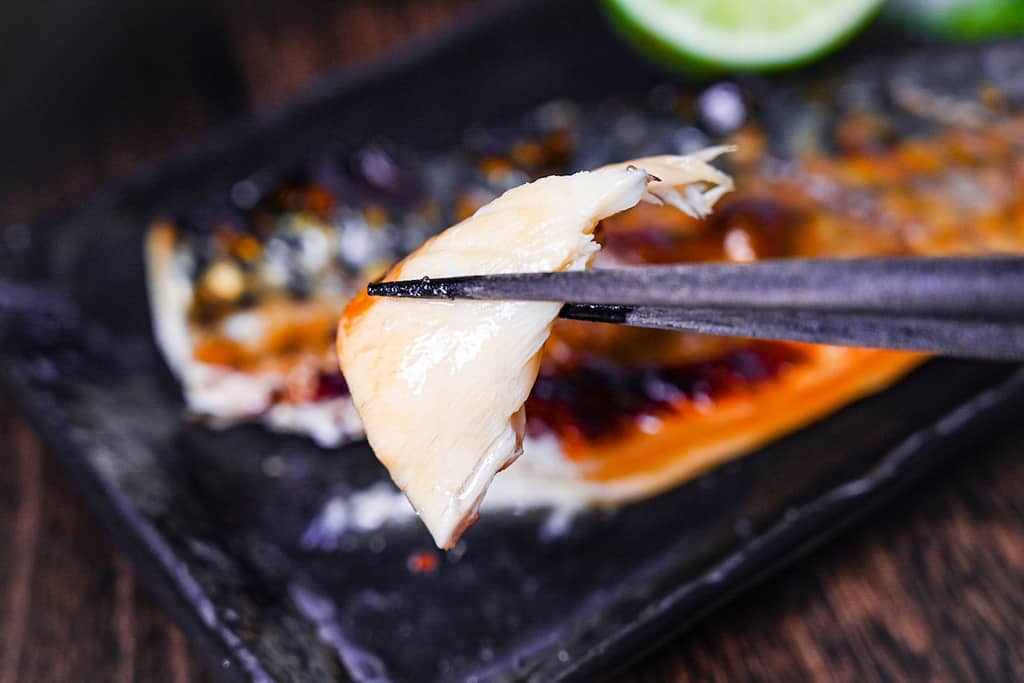
I hope you enjoy this Saba no Shioyaki recipe! If you try it out, I’d really appreciate it if you could spare a moment to let me know what you thought by giving a review and star rating in the comments below. It’s also helpful to share any adjustments you made to the recipe with our other readers. Thank you!
More Japanese Fish Recipes
- Shiozake (Japanese Salted Breakfast Salmon)
- Miso Glazed Salmon (pan fried)
- Sanma no Shioyaki (Grilled Pacific Saury)
- Sakana no Nitsuke (Japanese simmered fish)
Hungry for more? Explore my fish recipe collection to find your next favorite dishes!
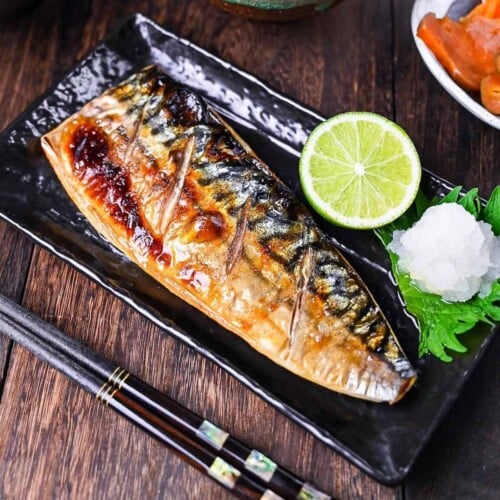
Saba no Shioyaki (Japanese Style Grilled Mackerel)
Ingredients
- 2 mackerel fillets skin-on
- 1 tbsp sake
- salt
- 1 wedge sudachi optional
- grated daikon radish (daikon oroshi) optional
My recommended brands of ingredients and seasonings can be found in my Japanese pantry guide.
Can’t find certain Japanese ingredients? See my substitution guide here.
Instructions
- Wash 2 mackerel fillets under cold running water and place them in a container. Pour 1 tbsp sake over the surface and rub it over both sides.Cover the container and rest in the fridge for 15 minutes, 30 minutes if you have time.

- Once rested, remove the mackerel from the fridge and preheat your oven grill or broiler on a medium-high/high setting. While you wait, dry the surface of the mackerel with kitchen paper on both sides.

- Sprinkle a generous pinch of salt from a height on each side, this will help evenly distribute it.

- Make 3 shallow, diagonal incisions on the skin of the mackerel.

- Place the fillets on the grill with the skin side down and grill the flesh side for 4 minutes. (Exact time might vary depending on the strength of your oven grill and the thickness of your fish.)

- Flip over and grill the skin side for 3 minutes or until crispy and lightly browned.

- Serve each portion 1 wedge sudachi and grated daikon radish (daikon oroshi) drizzled with a dash of soy sauce (optional).

- Enjoy!
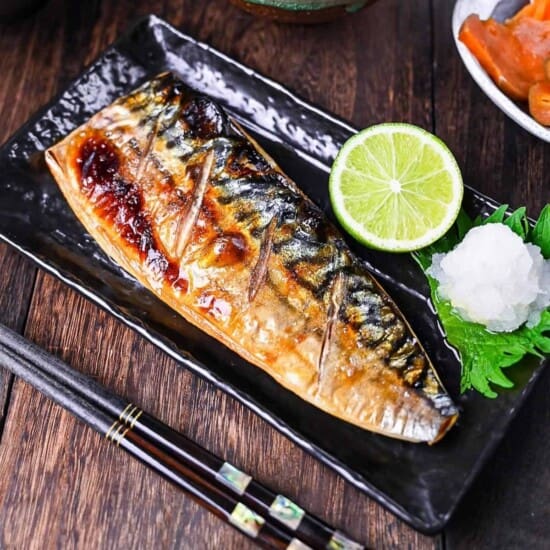




What kind of sake to use? Daiginjo? Plum sake? Nigori cloudy?
Thank you for your comment. The most suitable one is any kind of clear junmai sake. Honjozo sake is passable too. However, daiginjo, any kinds of cloudy ones or fruits wine would not be suitable. I hope this answers your question!
I have some daiginjo junmai sake leftovers so I just use 2 tablespoon to marinate the fish, for a short time. Didn’t see this comment before I cook, but maybe because it was only less than 5 minutes I didn’t feel anything different with my grilled fish. I will try using normal cooking sake next time… thank you!
JAPON FOOD VERY NAYS Tenkyou
Thank you!
I just made this, thank you! Marinate the fish in sake gives them extra oomph factor, nice!
Thank you for the comment and sharing your picture! Nice!
Wauw this tasted amazing!
Thanks for the recipe
Hi Len,
Thank you so much! I’m glad to hear you enjoyed! 🙂
Yuto
I think there’s an error in Steps 6/7…should be “flesh-side” down.
I cook the flesh side first and skin side second so that it’s nice and crispy upon serving. I’ve reworded the recipe a little to make it clearer. Thank you for your comment!
This was delicious and so easy. I used an air fryer and added some olive oil to the fish, came out perfect. Family really enjoyed. Thank you!
Hi Kristen,
Thank you so much for trying this recipe! Love that you tried it in the air fryer! I’m really glad it turned out so well for you all.
Yuto